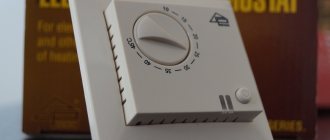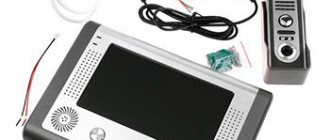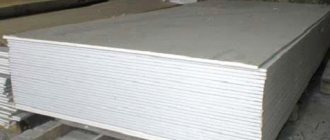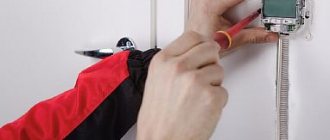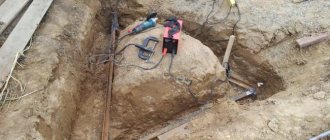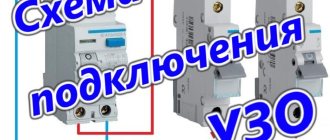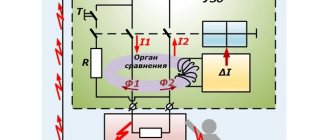Manual and automatic adjustment of room temperature from modern heating sources is carried out using thermostats or thermostats.
They are mechanical and electronic. Each of them has its own pros and cons.
Among electronic models, three types are most widespread:
- thermostat for water heating
- for electric underfloor heating
- for gas boilers or boilers
In appearance, they are all very similar to each other, but their circuitry is different.
Let's take a closer look at the features of connecting a thermostat to a gas boiler, its diagram, errors and possible problems when operating such devices.
Benefits of using a thermostat
To choose the right thermostat model, turn it over and carefully examine the back side. Namely, the diagram, inscriptions and contact blocks.
If it says “Dry Contact”, you have made the right choice. This is the designation for thermostats designed to work with gas boilers.
The term “dry contact” means that in any condition there is no voltage at these terminals. That is, the supply of 220V power to the L and N blocks of the thermostat will not be connected in any way to the dry contacts, and the voltage will never get there.
Unlike underfloor heating thermostats, as in the diagram below. Their power supply contacts (3-4) and load contacts (1-2) are connected directly to each other.
Why do you need this thing for a gas boiler? Without such a programmer, the boiler, after reaching the set temperature, will operate with a delay of approximately 3 minutes.
It turned on, worked, reached the temperature and went out. After three minutes it turns on again and everything repeats in a new cycle. The device will start up about 200-240 times per day.
Thus, over the entire heating season, the gas boiler will turn on and off 40,000 times. By connecting a thermostat, you reduce these commutations several times, thereby achieving not only gas savings, but also reducing wear and tear on heating equipment.
Global Tool
Price on the website: 4108 rub.
Overall rating: 4.6
This model is suitable for those who are looking for a thermostat with a large display. Modern design with touch screen combined with simple operation. The device synchronizes with applications. Allows centralized management with support for device sharing. Displayed parameters of weather, ultraviolet index and humidity will help you decide on your choice of clothes for the next day. Built-in IP20 protection class. Data memory and locking functions also add convenience. The seller offers different versions of the model.
buy on aliexpress
What temperature should I set?
The logic of work here is as follows. In factory settings, the boiler heats water according to the coolant temperature.
By installing an external thermostat, we thereby give it a command to heat the water not as the boiler wants, but according to the settings of the thermostat, i.e. to a certain temperature in a particular room.
With normal insulation of the house and minimal heat loss, a gas boiler with a thermostat will operate for only 3-4 hours per day.
If the thermostat after installation did not affect the operating time of the boiler in any way, then most likely the temperature on the gas appliance is set lower than necessary. The regulator sensor simply does not have time to warm up to the desired value and operate, while the temperature of the coolant has already reached the specified threshold.
The instructions separately specify the minimum temperature on the boiler when using an external thermostat. As a rule, it should be at least 65 degrees.
Initially, it is recommended to set the design temperature on the heating device, which completely covers the heat loss of the building. When these heat losses are not known, values from 60 to 70C are taken for a standard heating system.
If you live in a relatively warm climate, and in winter you do not raise the temperature in the batteries above 45C, you will still have to increase it to work with the thermostat.
Some people wonder, what is the point of installing a regulator and how does this lead to savings?
There is nothing to worry about because the temperature will be higher:
- firstly, the boiler cycles less, warms up the system faster
- secondly, at a higher coolant temperature, the heat in the rooms lasts longer
- and the maximum efficiency of batteries is observed precisely at t 65C-70C, and not at +45C
Settings
To enter the programming menu, press and hold the “SET” button (about 5 seconds).
You will enter the main settings menu. To switch modes P0…P8, press + or -. To change modes P0 ... P8, press the “SET” button again, then + or -. Long press SET (about 5 seconds) or within 10 seconds if no button is pressed, the menu will be memorized and exited. P0
- Cooling / Heating - C / H
(Set H, for heating) P1
- hysteresis settings - 0.1 - 30
(Set optimally 0.3) P2
- setting the upper limit +110 ° C (110 did not touch)
P3
- setting the lower limit - 50 ° C (-50 did not touch)
P4
- Temperature error correction -7 ... +7 ° C (did not touch, there is no point, the temperature is set by feeling once, and what it will be shown on the screen does not matter)
P5
- Delay start time - 0 ... 600 sec
(Different versions have different values, I have a maximum of 300, you need to set the maximum, which is 10 minutes) P6
- Alarm signal (did not change)
P7
- Upper alarm temperature threshold - 0 ... 110 ° C (OFF) (did not change)
P8
- Reset to factory settings - S/N (when switching the parameter, all settings are reset)
The boiler is set to a slightly higher coolant temperature than usual. This setting acts as a reserve in case of extreme cold. Or, for example, after peeling potatoes and showering, quickly heat the room and not overheat it. Parameter P5
I intentionally push it to the maximum. since the hysteresis is small, 0.3 degrees, so that the boiler does not twitch constantly. This gives him a pause to rest the pump and the ignition relay. This increases the life of the boiler. For a boiler, such pauses are the norm. Remember how often you use hot water. These are the same pauses.
Where and where to connect the wires on a gas boiler?
To connect the thermostat from the boiler terminal block to the Dry Contact contacts, you need to connect two conductors.
According to the instructions, the recommended cross-section of copper conductors is at least 0.75 mm2.
The cable length to the thermostat installation site should not exceed 50 meters.
Look for the necessary terminals on the boiler itself in the manufacturer's instructions, or refer to the inscriptions on the terminals.
These terminals are most often located on the back of the control board.
However, sometimes manufacturers take them outside the board.
During installation, some installers also connect the cable here and take it out, so that the consumer does not later go to the board and mess up something. Since the thermostat has not yet been installed, the ends of the cable are short-circuited.
By the way, be careful with this remote pad. Some consumers have encountered the problem of factory wires being mixed up, such as with Protherm.
As a result, everything started to work as it should, only when connected back.
Initially, there is a jumper between the terminals. If the jumper is broken, the gas boiler will simply stop working.
When connecting the thermostat, the factory jumper is removed and a cable laid to the installation site of the thermostat is installed in its place. The most important thing is that you don’t need to change any internal settings on the boiler.
A low voltage control pulse (usually 24V) is supplied through these contacts.
We have a control device (thermostat) and a slave (boiler). Between them, a set of requests and responses is constantly transmitted over a low-current line.
The principle of operation here is simple - by closing the dry contact, we thereby allow the operation of the boiler, by opening it, we interrupt the data transfer and prohibit it. Closing and opening occurs through the thermostat relay, depending on the set temperature on the device and comparison of the current readings in the room.
When triggered, the burner is first switched off, then after a certain period (pump run-on time) the circulation pump is switched off. Although the pump operation algorithm may differ in different models.
One of the algorithm options
It is not advisable for the pump to turn off immediately after the thermostat is activated. In this case, set the run-on time from 5 to 10 minutes in the menu. Then the entire heating system will cool evenly and the time intervals for automatic operation will increase.
On expensive models that support the OpenTherm protocol, through a remote programmer you can control many built-in parameters of the boiler, and not just turn it on and off.
Here are clear examples of where to connect the thermostat for different boiler models:
BaxiBoschElectroluxVaillantJunkersBuderusViessmanFerroliAtronAlfa CalorImmergas
What happens if the thermostat fails? How will the boiler behave in this case?
It all depends on the position in which the dry contact remains. If it is closed, nothing bad will happen. The boiler will simply start operating according to its last set program.
If it is open, the heating will not start and will not work.
Please note that the thermostat does not affect the operation of the burner in hot water supply mode.
A voltage of 220V is supplied to the power contacts of the thermostat - phase and zero (L and N). This can be done either from a separate outlet or junction box, or taken directly from the boiler itself.
On a regulator with dry contacts, it makes no difference where the phase or zero is connected, but on models for electric underfloor heating this plays a significant role in the issue of operational safety.
Since if the connection is incorrect, only the neutral conductor will break, and the phase will be constantly on duty on the heating cable.
Piping an open gravity system in a private house
It consists of a single device - an open expansion tank, the functions of which are as follows:
- Compensation for excess heated water.
- Protection against pressure surges in the system.
- Removal of air and steam in case of boiling of the coolant.
When selecting the tank volume, the already familiar 10% of the total volume of water in the system is used, with a small margin.
The most optimal point for installing the tank is the top of the heating circuit. An accelerating manifold is installed immediately behind the tank: this is the name given to the vertical spill area after the boiler. So that air accumulations can easily escape into the atmosphere, and water flows by gravity, the section of the system between the tank and the heat exchanger is given a slight slope. For the convenience of replenishing the constantly evaporating coolant, the tank is often equipped with a cold water supply. Date: September 25, 2022
Mechanical or electronic thermostat
By the way, for a gas boiler you can use another simple type of regulator, which does not even have to be supplied with 220V voltage. For example, a mechanical thermostat Termec Emmeti or other similar models.
Here is a "normal" Termec wiring diagram.
You need to use only normally closed contacts 1 and 3, completely eliminating 220V alternating voltage (L and N).
The built-in sensor will close and open the internal contact when the temperature in the room changes. He doesn't need any nutrition. In this case, the entire logic of heating operation is similar to that discussed earlier.
Just don’t forget that almost all mechanical models have a very large hysteresis. You cannot create a comfortable room temperature with their help.
Therefore, whenever possible, choose electronic devices with a WiFi connection. Fortunately, nowadays you can find very decent and inexpensive options from the Chinese.
For example, such as this one (thousands of satisfied customers and positive reviews).
More details
Some models have contacts labeled NO (normally open), NC (normally closed) and COM (common). Someone advises connecting through them, namely through NC and COM.
However, be careful, there are different thermostats and always read the instructions. An alternating voltage of 220V can also be supplied through them, and you will thereby start a phase on the control board where it is not needed.
Here is a striking example of such multifunctional regulators Fluoreon and Beok.
On multifunctional devices, the temperature in the room is also determined using the built-in temperature sensor.
However, they have terminals on the body for connecting and external (Sensor). It is most often used for heated floors.
The best known manufacturers and models: characteristics and prices
BAXI KHG
A well-known simple mechanical thermostat without additional functions or settings. Among mechanical analogues, it is distinguished by Italian build quality and reliability, standard hysteresis of 1°C, and minimalistic, pleasant design. The disadvantages are standard for all mechanical devices - high error, temperature steps of 1°C rather than 0.5°C, constant hysteresis.
TEPLOCOM TS-Prog-2AA/8A
Wired programmable electronic thermostat. It is distinguished by the presence of almost all the functions available today at a low price, essentially the best choice in terms of price-quality ratio.
It has a good contrast display, the ability to set minimum and maximum temperatures, pump protection mode, protection against overheating and freezing, indication of system malfunction, setting hysteresis, programming temperature schedules for 7 days, etc.
The disadvantages are the wired connection and, despite this, power from 2 AA batteries, they are enough for 1-1.5 years of operation.
TEPLOCOM TS-Prog-2AA/3A-RF
The programmable thermostat is absolutely similar to the previous model, but with a wireless connection at a frequency of 868 MHz, which means an increase in the reception range up to 100 meters. The receiver is connected to the boiler via a wired connection. The disadvantage of this model is its rather high price, since wired analogs for this price can have built-in Wi-Fi and GSM modules, and the kit includes sensors for heated floors.
TEPLOLUX MCS-350
One of the best room thermostats for a heating boiler. It has almost all modern monitoring and protective functions, 24/7 programming mode, and detailed consumption statistics. It is distinguished by the presence of a touch LCD display with automatic locking, the presence of a Wi-Fi module that allows you to control the system from a smartphone, and an additional remote temperature sensor included (up to 32 sensors can be connected in total).
Thanks to Wi-Fi, the thermostat can be installed in any inconspicuous place and controlled from a smartphone, but even with an open installation, it will harmoniously fit into almost any interior.
Installation location
As you know, the air temperature in a room with traditional radiator heating systems warms up unevenly. It is lower near the floor, higher under the ceiling.
Based on the presence of a built-in temperature sensor in thermostats, their installation height is regulated.
Such thermostats should be placed at a height of 1.2-1.5 m from the floor level and as far as possible from heating sources, including protection from direct sunlight.
It is also not recommended to place thermostats in the hallway or kitchen.
Room thermometer with liquid
Until now, filled thermometers are considered one of the most accessible temperature measurement sensors. A liquid is added to the tube that is sensitive to changes in temperature, most often colored alcohol or mercury. As the temperature level outside the tube changes, the liquid expands and rises; using the dial table, you can determine what temperature level is currently in the room. This method is good if high accuracy is not required, because when using such a meter, an error of almost a degree is possible, in addition, alcohol models very quickly lose their readings with a sharp change in temperature, they are difficult to record.
Photo - Room thermometer with liquid
The liquid must have a relatively large coefficient of thermal expansion, so that small changes in temperature will result in detectable changes in volume. The tube material is glass, sometimes tempered, but always transparent so that the marked table can be seen. Mercury used to be more common, but its toxicity levels are too high to cause irreparable damage in household use.
Although filled regulators are the simplest and cheapest options for measuring temperature, they are also not durable due to their fragility. They are also rarely used in even small production processes, because there is no way to regulate their operation automatically.
Connecting a heated floor thermostat to a gas boiler
Consumers often wonder whether it is possible to use a standard 220V thermostat for underfloor heating to work with a gas boiler?
What if you haven’t found a special thermostat with dry contacts, but you already have a model for heated floors in stock. Such a connection is possible.
However, for this you will need to “untie” the 220V voltage. In most underfloor heating thermostats, it comes to the power terminals and is then removed from the terminals going to the heating cable. And as mentioned above, when working with a gas boiler, “dry contacts” are used, through which low voltage pulses are transmitted.
If you directly connect the cable from the boiler control board here, you will cause a short circuit and damage your boiler.
For a safe connection, you will have to add an intermediate relay or an additional contactor with normally open contacts to the circuit.
From the thermostat terminals, instead of the underfloor heating cable, you supply 220V voltage to the relay coil (contactor), and through its normally open contacts (1-2 or 3-4), connect the wires to the gas boiler.
The principle of operation here is the same as discussed earlier. However, keep in mind the following feature.
Since this is a thermostat for heated floors, most likely it will work according to the scheme: air sensor + floor sensor. This means that it will require you to install and set a temperature limit using a floor sensor, which you will not have.
Therefore, in the settings you will have to unplug the floor sensor and leave only the air sensor in operation. How to do this, read in detail in the instructions for your model. There may be differences between different devices.
For example, with the Devi Touch, for this you have to break a special jumper on the back side.
In order to avoid all these difficulties and problems, it is better to initially choose the right thermostat model.
Prices: summary table
| Manufacturer and model | Peculiarities | Cost, rub. | Our rating, 0-5 points |
| BAXI KHG | Mechanical, inexpensive and reliable | 1 350 | 3,9 |
| TEPLOCOM TS-Prog-2AA/8A | Programmable, wired, functional, best in price-quality ratio | 3 600 | 4,5 |
| TEPLOCOM TS-Prog-2AA/3A-RF | Programmable, wireless, functional, expensive | 5 500 | 4,3 |
| TEPLOLUX MCS-350 | Programmable, wired, functional, with Wi-Fi module and touch display, with additional. sensor, modern stylish design | 5 200 | 4,9 |
